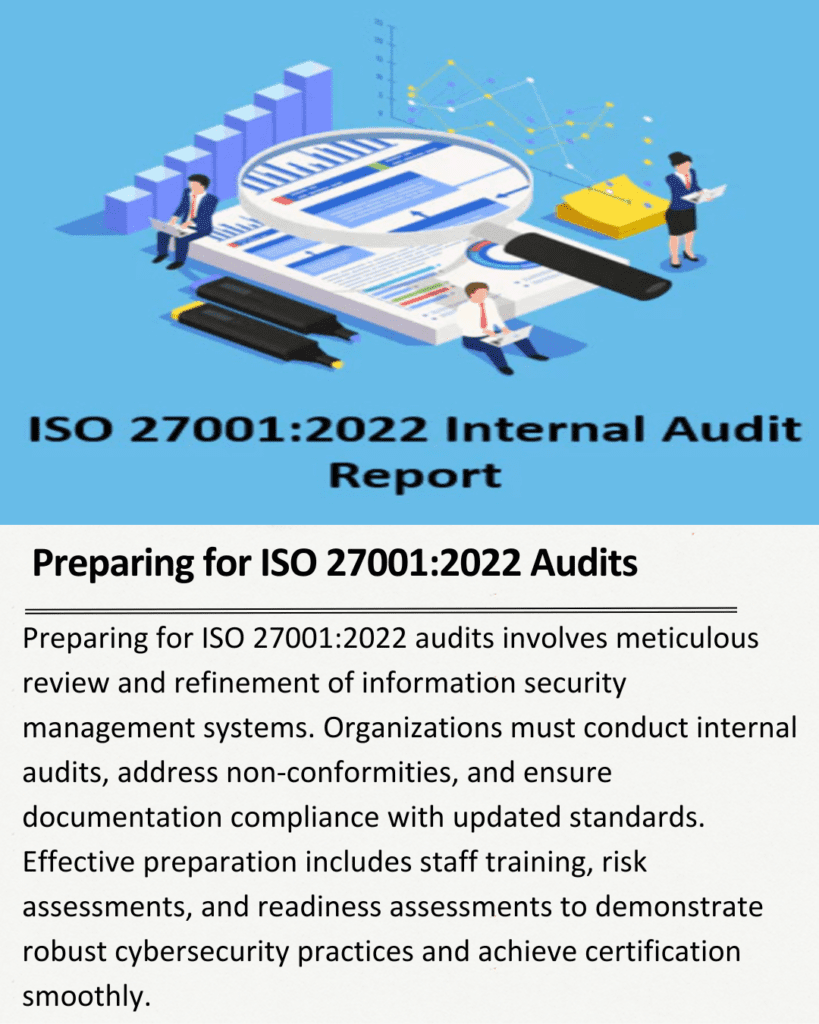Subtotal $0.00

Preparing for ISO 27001:2022 audits involves thorough planning and execution to streamline processes and ensure compliance. Here’s a detailed guide on how organizations can effectively prepare for these audits:
Introduction to ISO 27001:2022 Audits
ISO 27001 is a globally recognized standard for information security management systems (ISMS), designed to help organizations manage and protect their information assets. Regular audits are crucial for verifying compliance with ISO 27001 requirements, ensuring continuous improvement in information security practices.
Understanding ISO 27001:2022 Updates
ISO 27001:2022 introduces several updates aimed at enhancing the standard’s relevance and effectiveness in today’s cybersecurity landscape. These updates may include changes in risk assessment methodologies, updated controls to address emerging threats, and improved alignment with other standards and regulations.
Steps to Prepare for ISO 27001:2022 Audits
1. Gap Analysis and Readiness Assessment
Before undergoing an ISO 27001:2022 audit, organizations should conduct a comprehensive gap analysis. This involves comparing current information security practices against the requirements of the updated standard. A readiness assessment helps identify areas needing improvement and prepares the organization for the audit process.
2. Establishing Clear Objectives and Scope
Define the scope of your ISMS clearly. This includes identifying the boundaries of the information security management system within your organization. Establishing clear objectives ensures that audit efforts are focused and aligned with organizational goals.
3. Documenting Policies, Procedures, and Controls
Documenting ISMS policies, procedures, and controls is essential for demonstrating compliance during audits. Ensure that documented information is accurate, up-to-date, and accessible to auditors. Align documented controls with ISO 27001:2022 requirements and ensure they reflect organizational practices effectively.
4. Implementing Risk Management Processes
ISO 27001:2022 places significant emphasis on risk management. Implement robust risk assessment and treatment processes tailored to your organization’s risk tolerance and business objectives. Document risk assessments, treatment plans, and residual risks to provide auditors with evidence of proactive risk management practices.
5. Training and Awareness Programs
Educate personnel on their roles and responsibilities within the ISMS framework. Conduct regular training sessions and awareness programs to ensure staff understand information security policies, procedures, and their contributions to compliance. Training programs should cover both technical aspects of ISMS and general security awareness.
6. Internal Audits and Reviews
Conduct regular internal audits to assess ISMS performance and identify non-conformities. Internal audits help organizations identify areas for improvement before external ISO 27001:2022 audits. Schedule audits periodically, document findings, and implement corrective actions to address identified issues.
7. Management Review Meetings
Hold management review meetings to evaluate ISMS effectiveness and identify opportunities for improvement. Management involvement demonstrates commitment to information security and ensures that resources are allocated appropriately to address ISMS objectives. Document management review outcomes and actions taken to enhance ISMS performance.
8. Preparing Documentation for Auditors
Compile necessary documentation for auditors, including ISMS policies, procedures, risk assessments, internal audit reports, and management review records. Ensure documentation is organized, easily accessible, and aligned with ISO 27001:2022 requirements. Provide auditors with access to relevant information and facilitate their review process.
9. Engaging External Auditors
Select a reputable certification body or external auditor accredited to conduct ISO 27001:2022 audits. Communicate expectations, provide access to documentation, and facilitate audit activities to ensure a smooth audit process. Collaborate with auditors to address inquiries, clarify observations, and demonstrate compliance effectively.
10. Continual Improvement and Post-Audit Actions
After completing ISO 27001:2022 audits, analyze audit findings and identify opportunities for continual improvement. Implement corrective actions to address non-conformities and enhance ISMS performance. Monitor progress, conduct follow-up activities, and update documentation as necessary to maintain compliance with ISO 27001:2022 requirements.
Conclusion
Preparing for ISO 27001:2022 audits requires proactive planning, meticulous documentation, and continuous improvement efforts. By conducting gap analyses, implementing robust ISMS practices, engaging stakeholders, and collaborating with auditors, organizations can streamline audit processes and ensure compliance with updated standards. Adhering to ISO 27001:2022 principles not only enhances information security but also strengthens organizational resilience against evolving cybersecurity threats.